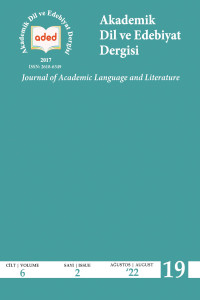Öz
The curiosity of people about the unknown has revealed itself as a desire to learn fortune-telling and its methods. Issues such as the result of a job to be done, the fate of the trip, the issue of marriage and having children are perhaps the topics that people most desire to be interpreted and the first way they resort to for this is usually fortune-telling. The fact that the word fortune-telling and its culture have an equivalent in eastern and western languages also supports this situation. Works such as falnâme, starnâme, remilnâme and tefeʾülnâme in the manuscript archives of the libraries show that there is a learning-teaching effort about the fortune telling itself and the methods of looking. These types of works, which are sometimes written with the concern of aesthetics and sometimes serving a purpose, are a source of reference. Issues such as the result of a job to be done, the fate of the trip, the issue of marriage and having children are perhaps the topics that people most desire to be interpreted.The book of Kolay Remiller, which is the subject of our study and is an example of remilname, contains 16 intentions/questions and 16 comments/answers for 16 different letters according to these intentions. There has been no previous scientific study on the Arabic translation of Sheikh Ahmed Zenati's work. In this article, the work named Kolay Remiller will be examined, the purpose of writing the work and the method of applying the fortune-telling will be mentioned, and the transcripted text of the work will be included at the end of the study.
Anahtar Kelimeler
Remil Tefeul tradition Classical Turkish literature Zenati Süleyman el-Hüseyni
Kaynakça
- Aydın, M. (1995). “Fal”. Türkiye Diyanet Vakfı İslam Ansiklopedisi. (s.134-138). T ürkiye Diyanet Vakfı Yayınları. https://islamansiklopedisi.org.tr/fal
- Bahadır, S. C. (2020). Matbu Bir Remilnâme Örneği. Selçuk Üniversitesi Edebiyat Fakültesi Dergisi, 43, 221-242.
- Çelebi, İ. (1995). “Fal”. Türkiye Diyanet Vakfı İslam Ansiklopedisi. (s.138-139). Türkiye Diyanet Vakfı Yayınları. https://islamansiklopedisi.org.tr/fal#2-islamda-fal
- Çelebi, İ. (2007). “Remil”. Türkiye Diyanet Vakfı İslam Ansiklopedisi. (s.555-556). Türkiye Diyanet Vakfı Yayınları. https://islamansiklopedisi.org.tr/remil
- Ekmeleddin İ. & Şeşen, R. (2011). Osmanlı Astroloji Literatürü Tarihi ve Osmanlı Astronomi Literatürü Zeyli, IRCICA Yayınları.
- Eren, H. (2021). Tefe’ül Geleneği Bağlamında “Su’âl ve Cevâblı Tefe’ülnâme Yâhûd Kolay Remiller. AÇÜ Uluslararası Sosyal Bilimler Dergisi, 7 (2), 105-128.
- Mermer, A., & Koç Keskin, N. (2016). Eski Türk Edebiyatı Terimler Sözlüğü. Akçağ Yayınları.
- Parlatır, İ. (2012). Osmanlı Türkçesi Sözlüğü. Yargı Yayınevi.
- Redhouse, J. W. (2016). Müntehabât-ı Lügât-i Osmâniyye. Türk Dil Kurumu Yayınları.
- Tekin, T. (2004). Irk Bitig-Eski Uygurca Fal Kitabı. Öncü Kitap.
- Türk Dil Kurumu. (2022). Güncel Türkçe Sözlük. Erişim Tarihi: Haziran, 29, 2022, https://sozluk.gov.tr
- Uygun, A. (2013). Seyyid Süleyman el-Hüseynî’nin Kenzü’l-Havâs Kitabındaki Dua ve Büyü Motifleri. [Yayımlanmamış Doktora Tezi]. Süleyman Demirel Üniversitesi Sosyal Bilimler Enstitüsü.
- Uzun, M. İ. (1995). “Falnâme”. Türkiye Diyanet Vakfı İslam Ansiklopedisi. Türkiye Diyanet Vakfı Yayınları. (s.141-145). https://islamansiklopedisi.org.tr/falname
Öz
İnsanın bilinmeyene dair duyduğu merak kendini fal bakma ve yöntemlerini öğrenme arzusu olarak ortaya çıkarmıştır. Yapılacak bir işin neticesi, çıkılacak seyahatin akıbeti, evlilik ve çocuk sahibi olma meselesi gibi hususlar insanların belki de yorumlanmasını en çok arzuladıkları konulardır ve bunun için başvurdukları yolların ilki genelde fal bakmak/baktırmaktır. Hem doğu hem de batı dillerinde fal kelimesinin ve kültürünün bir karşılığının bulunması bu durumu destekler niteliktedir. Kütüphanelerin yazma eser arşivlerinde yer alan falnâme, yıldıznâme, remilnâme ve tefeʾülnâme gibi eserler falın kendisine ve bakma yöntemlerine dair bir öğrenme-öğretme çabasının olduğunu göstermektedir. Kimi zaman estetik kimi zaman da amaca hizmet kaygısı ile yazılan bu türdeki eserler birer başvuru kaynağıdır. Çalışmamıza konu olan ve bir remilnâme örneği olan Kolay Remiller kitabı 16 niyet/soru ve bu niyetlere göre 16 farklı harf için 16 yorum/cevap içermektedir. Şeyh Ahmed Zenâtî’ye ait Arapça’dan tercüme olan eser üzerine daha önce herhangi bir bilimsel çalışma yapılmamıştır. Bu makalede Kolay Remiller isimli eser incelenecek, eserin yazılış amacından ve falın uygulanma yönteminden söz edilecek ve çalışmanın sonunda eserin transkripsiyonlu metnine yer verilecektir.
Anahtar Kelimeler
Tefeʾül geleneği Süleyman el-Hüseynî Remil Zenâtî Klasik Türk Edebiyatı
Kaynakça
- Aydın, M. (1995). “Fal”. Türkiye Diyanet Vakfı İslam Ansiklopedisi. (s.134-138). T ürkiye Diyanet Vakfı Yayınları. https://islamansiklopedisi.org.tr/fal
- Bahadır, S. C. (2020). Matbu Bir Remilnâme Örneği. Selçuk Üniversitesi Edebiyat Fakültesi Dergisi, 43, 221-242.
- Çelebi, İ. (1995). “Fal”. Türkiye Diyanet Vakfı İslam Ansiklopedisi. (s.138-139). Türkiye Diyanet Vakfı Yayınları. https://islamansiklopedisi.org.tr/fal#2-islamda-fal
- Çelebi, İ. (2007). “Remil”. Türkiye Diyanet Vakfı İslam Ansiklopedisi. (s.555-556). Türkiye Diyanet Vakfı Yayınları. https://islamansiklopedisi.org.tr/remil
- Ekmeleddin İ. & Şeşen, R. (2011). Osmanlı Astroloji Literatürü Tarihi ve Osmanlı Astronomi Literatürü Zeyli, IRCICA Yayınları.
- Eren, H. (2021). Tefe’ül Geleneği Bağlamında “Su’âl ve Cevâblı Tefe’ülnâme Yâhûd Kolay Remiller. AÇÜ Uluslararası Sosyal Bilimler Dergisi, 7 (2), 105-128.
- Mermer, A., & Koç Keskin, N. (2016). Eski Türk Edebiyatı Terimler Sözlüğü. Akçağ Yayınları.
- Parlatır, İ. (2012). Osmanlı Türkçesi Sözlüğü. Yargı Yayınevi.
- Redhouse, J. W. (2016). Müntehabât-ı Lügât-i Osmâniyye. Türk Dil Kurumu Yayınları.
- Tekin, T. (2004). Irk Bitig-Eski Uygurca Fal Kitabı. Öncü Kitap.
- Türk Dil Kurumu. (2022). Güncel Türkçe Sözlük. Erişim Tarihi: Haziran, 29, 2022, https://sozluk.gov.tr
- Uygun, A. (2013). Seyyid Süleyman el-Hüseynî’nin Kenzü’l-Havâs Kitabındaki Dua ve Büyü Motifleri. [Yayımlanmamış Doktora Tezi]. Süleyman Demirel Üniversitesi Sosyal Bilimler Enstitüsü.
- Uzun, M. İ. (1995). “Falnâme”. Türkiye Diyanet Vakfı İslam Ansiklopedisi. Türkiye Diyanet Vakfı Yayınları. (s.141-145). https://islamansiklopedisi.org.tr/falname
Ayrıntılar
| Birincil Dil | Türkçe |
|---|---|
| Konular | Edebi Çalışmalar |
| Bölüm | Makaleler |
| Yazarlar | |
| Yayımlanma Tarihi | 30 Ağustos 2022 |
| Gönderilme Tarihi | 16 Temmuz 2022 |
| Kabul Tarihi | 8 Ağustos 2022 |
| Yayımlandığı Sayı | Yıl 2022 Cilt: 6 Sayı: 2 |
This work is licensed under Attribution-NonCommercial 4.0 International


